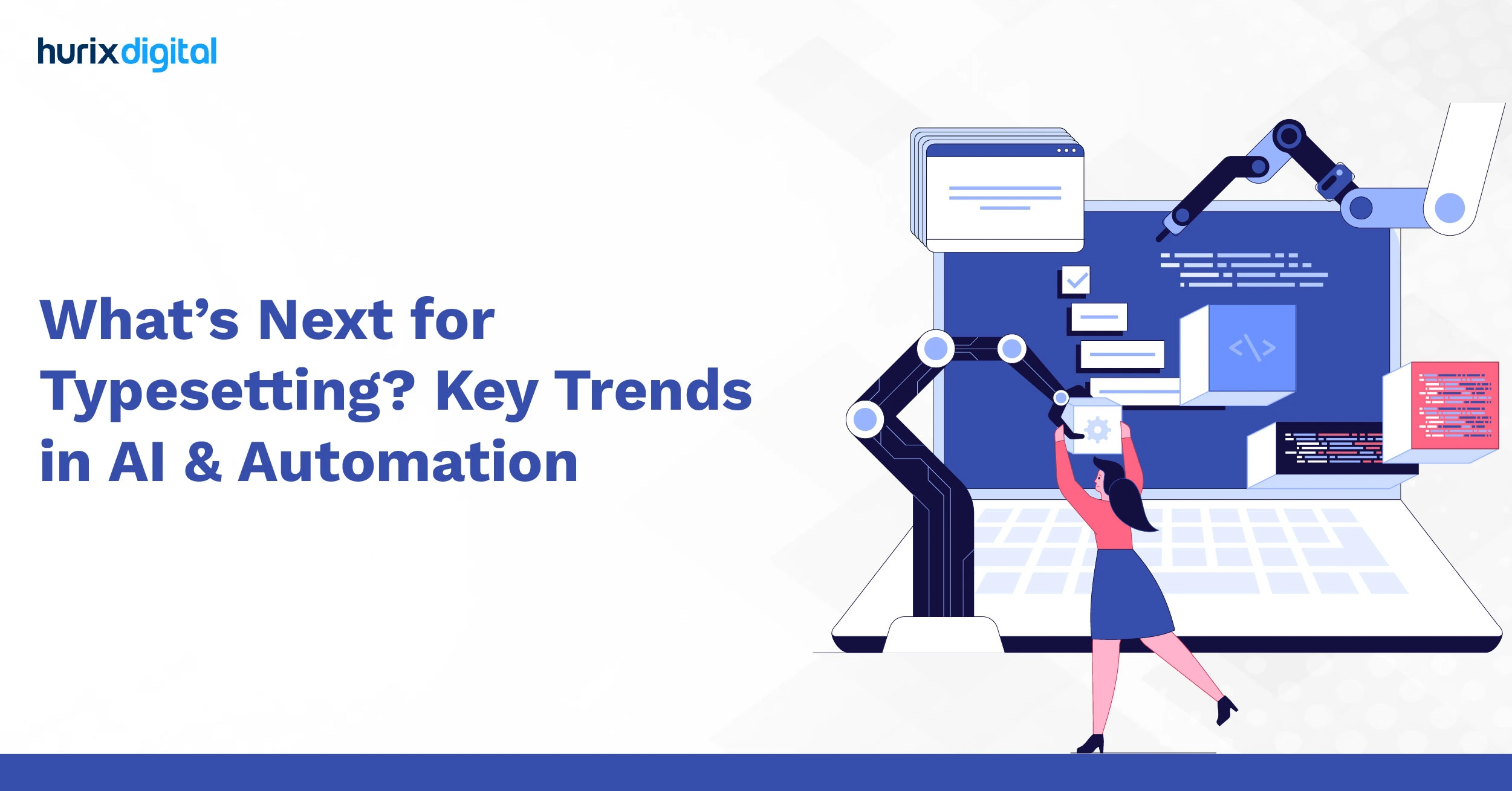
What’s Next for Typesetting? Key Trends in AI & Automation
Summarize with:
Did you know that self-published books bring in a revenue of $1.25 billion every year? Thanks to advancements in typesetting technology, manual typesetting is now a relic of the past, and self-publishing has become more accessible than ever. This evolution presents a unique opportunity for traditional publishing houses to enhance their operations. As the typesetting industry continues to evolve rapidly, tapping into this significant market potential requires publishers to adopt more efficient and precise formatting techniques.
Proper formatting can attract more readers and increase your sales, making it crucial for success. Automated typesetting is changing the landscape of the typesetting industry. To publish a well-designed book, you must understand the basics of automation in typesetting and discover the best typesetting practices to benefit you.
Table of Contents:
- What is a Typesetter?
- What is Typesetting in Publishing?
- What is Automation in Typesetting?
- How is Automation Changing the Landscape of Typesetting?
- Challenges in Typesetting Automation
- Best Practices and Solutions for Typesetting Automation
- Role of AI in Typesetting Automation
- What are the Predictions and Trends in the Automation Typesetting Industry?
- Conclusion
What is a Typesetter?
A typesetter is a person who specializes in typesetting. They provide typesetting services to produce well-organized, aesthetically pleasing text that is simple to understand.
In the past, typesetters painstakingly arranged metal or wooden type blocks by hand to create printed pages. Nowadays, with the advent of technological solutions, typesetters rely on sophisticated software programs such as Adobe InDesign, QuarkXPress, and LaTeX.
Typesetters are skilled in the technical aspects of formatting text, graphical elements, typography, and layout design. They employ these skills to help design magazine, graphic, and newspaper layouts and perform book typesetting.
What is Typesetting in Publishing?
Typesetting is a vital process in the publishing industry. It generally takes place after the final draft of the manuscript has been edited. Typesetting typically involves selecting and formatting fonts, page trim size, spacing, and margins.
It also entails arranging images, tables, and other graphic elements to create a visually appealing and easy-to-read printed or digital document. Carrying out this process not only enhances the reading experience but also gives your book a professional and eye-catching appearance.
What is Automation in Typesetting?
The whole purpose of automation is to remove the need for human intervention for repetitive, tedious, and time-consuming tasks. Automation tools used in typesetting handle tasks traditionally carried out by typesetters.
Automated typesetting software can format a manuscript’s content automatically, ensuring greater accuracy, efficiency, and productivity.
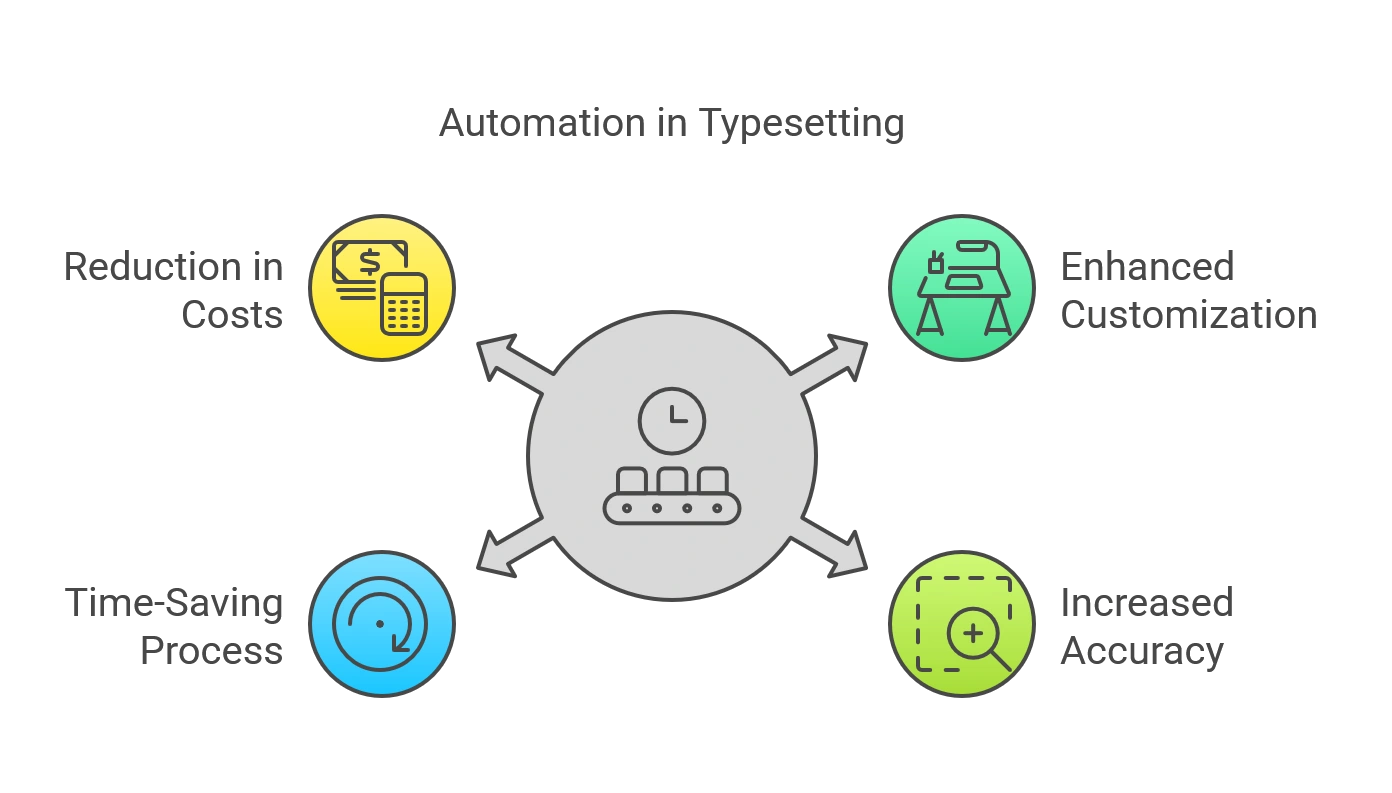
How is Automation Changing the Landscape of Typesetting?
Now that you know the basic terms and definitions, let’s understand how automation is changing the typesetting industry.
1. Enhanced Customization
With the rise of automation, typesetting now offers greater customization options. Automated typesetting software provides an array of templates and layouts to design your book’s pages. All you have to do is choose one, and the software takes care of everything else—from word spacing and font styles to margins, headers, footers, and even the placement of images and captions.
The formatting of pages takes place quickly, and the result is a formatted file. You can then preview your file format and better understand how your book will appear to your readers.
2. Increased Accuracy
Automation software runs checks for spelling, grammar, and language translation errors and refines the document, reducing the presence of human error. It also ensures consistency in paragraphs by eliminating the presence of orphans and widows.
In addition, this technology can typeset your book in a way that meets the typesetting or formatting standards of the publishing industry. This includes accessibility considerations.
Automation in typesetting increases the accuracy and quality of content by reducing errors and confirming industry standards.
3. Time-Saving Process
Unlike manual typesetting, where it took hours and days to format a book completely, automation can typeset books in mere minutes. Automation tools can process large amounts of text and images and accommodate changes and revisions.
Automation results in an efficiently produced, high-quality, well-formatted document, enabling you to get your books and other publications out quickly and giving you a competitive edge.
4. Reduction in Costs and Increased Profits
Automation can reduce labor, paper, and specialized equipment costs. Automation software can handle the typesetting process and fit the content optimally on pages without any manual help. The software frees up your time, which you can devote to other productive tasks.
In the long run, automation helps increase your bottom line and generate profits by saving costs and increasing productivity.
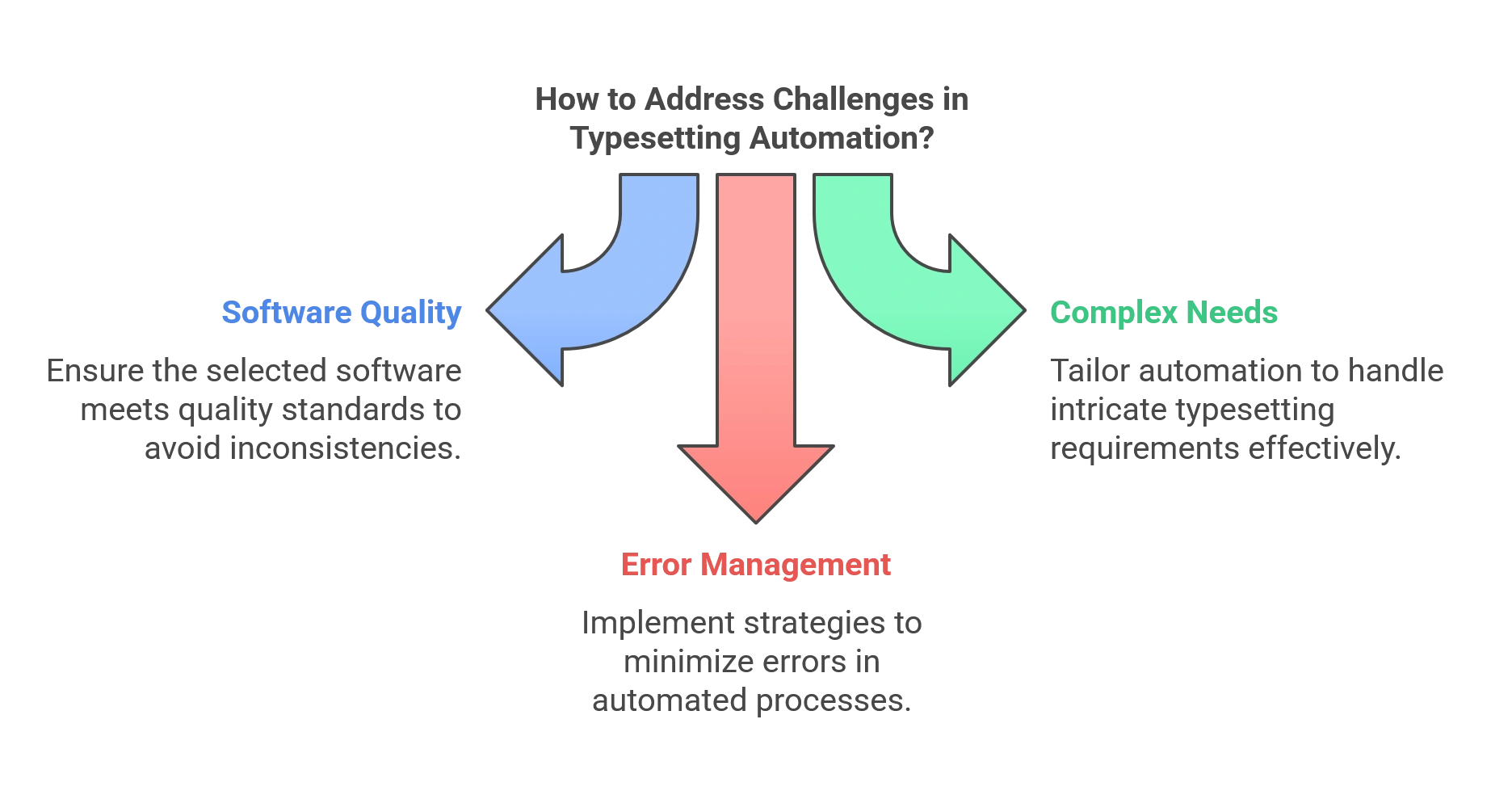
Challenges in Typesetting Automation
However complex the software is, its output will only be as good as the input provided by the user, and this is where a few challenges arise when it comes to typesetting automation. Let’s look at a few of them:
1. Not All Automated Typesetting Software is Made Equal
Today, there are several typesetting software programs available on the market. Some work best for the casual user, while others are designed for specific niches. With many options, publishers may struggle to choose the most appropriate one for their needs. Each of these has its own set of unique features, advantages, and limitations.
- Microsoft Word: The most common typesetting software we are all familiar with is Microsoft Word. While this works best for basic requirements, it does not possess the features and the level of control needed for the more serious typesetting needs that publishers or professional printers may require.
- Adobe’s InDesign and QuarkXpress: These are some of the more popular choices to achieve more professional typesetting. However, it is crucial to determine which one fits your unique requirements best. For example, InDesign offers more layout customizations according to the language of the content, i.e., text settings, bidirectional text flow, etc.
- LaTeX: Typesetting for scientific and technical documents involves much more complexity. Here is where you would need a dedicated typesetting software called LaTeX. It is a free and open-source typesetting system with a high level of control over the layout and formatting of text and equations, but it requires some coding skills and a steep learning curve.
- Web-Based Typesetting Software: This type of typesetting software falls somewhere between the options above. It sacrifices a few features, but it can be accessed from anywhere via a web browser. Scribus is a free and open-source web-based typesetting software similar to InDesign and QuarkXPress, but it has fewer features and less support.
Understanding your requirements is crucial before you begin a typesetting project to ensure you have invested in the software with the needed features.
2. Handling Complex Typesetting Needs
Automated typesetting systems can have difficulty typesetting documents with multiple languages and scripts without proper monitoring, user input, and intervention.
This problem gets amplified when different writing systems are involved, which can differ in directionality, punctuation, hyphenation, or font requirements. For example, some languages, such as Arabic and Hebrew, are written from right to left, while others, such as Chinese and Japanese, are written vertically.
Automated systems may one day learn to overcome such challenges themselves. Still, as of now, they have to rely on the skills of the typesetter to choose fonts that support all the languages and scripts and follow the rules and conventions of punctuation and hyphenation for each language or script.
3. Automation Software is Prone to Errors
Typesetting automation can help reduce human errors and inconsistencies in content, but it can also introduce new ones if not done carefully.
For example, Typesetting automation can also generate automatic cross-references, citations, bibliographies, indexes, etc., but it can also cause errors if the sources or formats are not consistent or accurate.
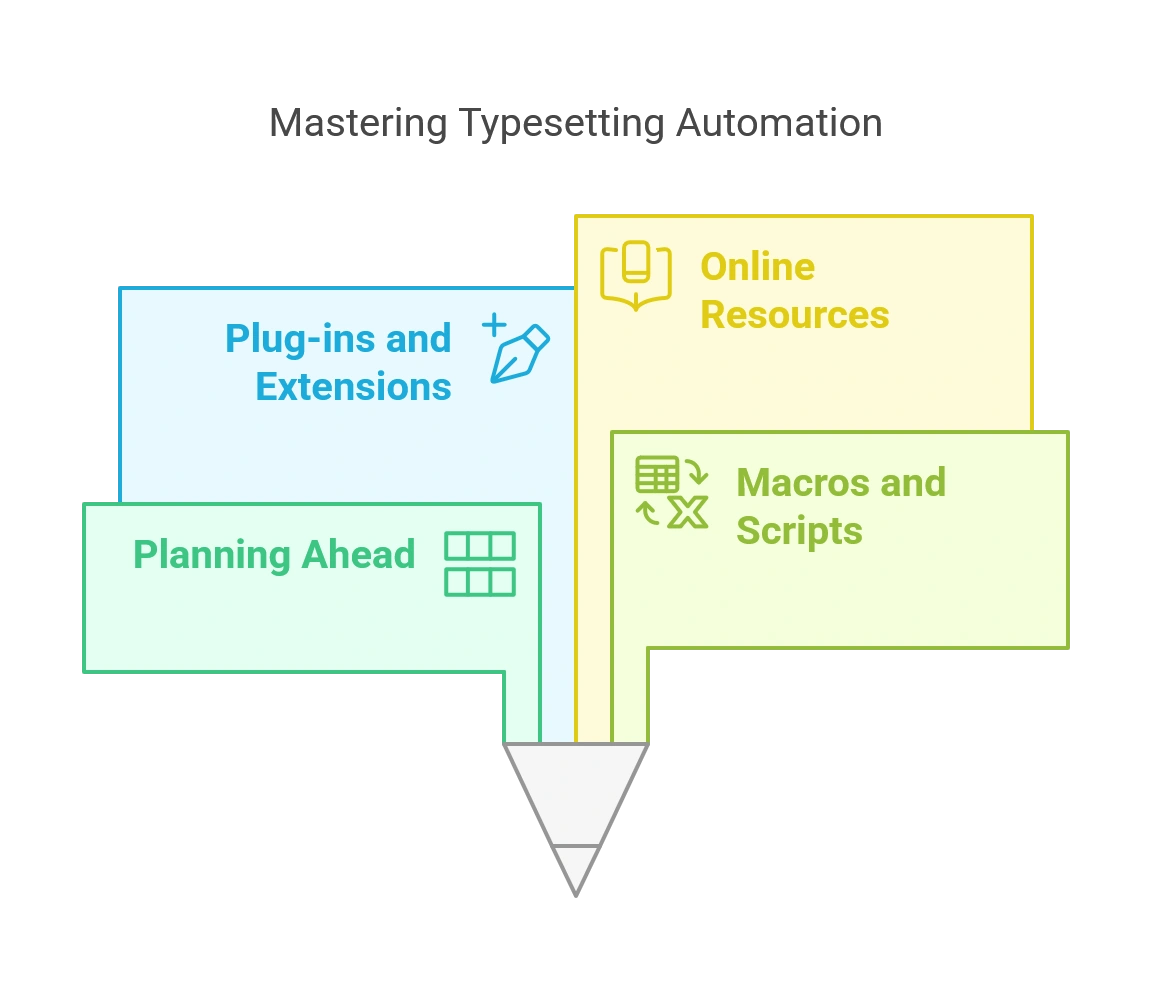
Best Practices and Solutions for Typesetting Automation
Knowledge, discipline, and sticking to a few best practices go a long way in overcoming challenges in typesetting automation. Some of these best practices are:
1. Plan Ahead
A proper plan is essential for the typesetting project’s success. Analyze the project’s scope, specifications, and requirements before selecting the best typesetting automation software based on its features and limitations.
2. Use Macros and Scripts
Macros and scripts are commands or instructions that can automate repetitive typesetting activities. A well-designed macro or script can accomplish complex or repeated operations with a single click, lowering the possibility of human error.
3. Use Plug-ins and Extensions
Plug-ins and extensions are features or functions that may be added to typesetting software to improve its capabilities. Some are designed and tested by the software’s developers, while others can be open-source and developed by typesetters with the needed programming expertise.
Plug-ins can assist typesetters in performing tasks typically not handled by typesetting software, such as importing or exporting data, converting formats, checking spelling and grammar, and so on.
4. Use Online Tools and Resources to Improve Your Knowledge of the Subject
A little extra knowledge never hurts, and you never know when it can help address certain challenges in typesetting automation systems or avoid them altogether. Today, forums and communities exist for almost every niche, where experts and people new to a field exchange ideas, share feedback, and more.
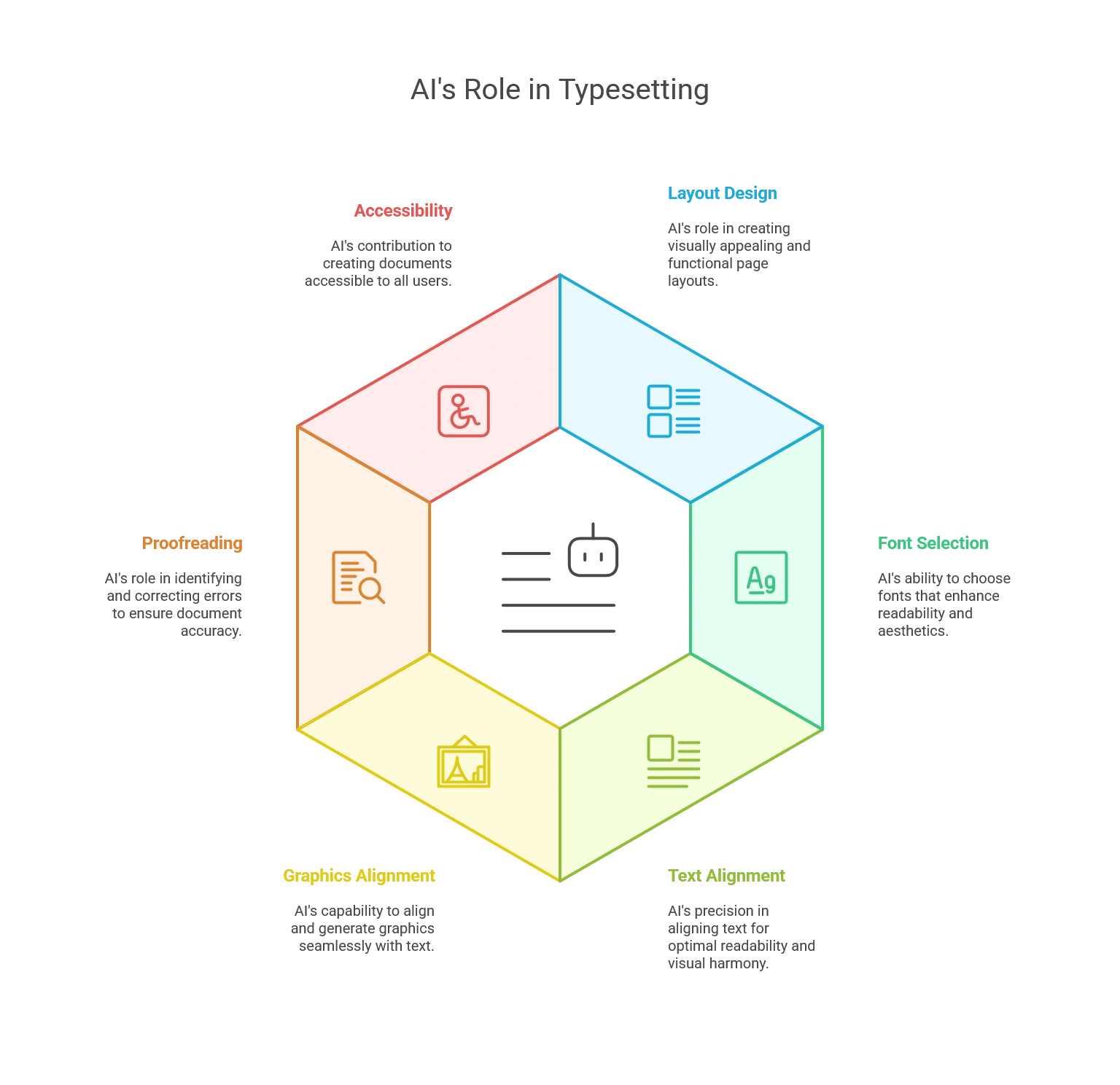
Role of AI in Typesetting Automation
Artificial Intelligence refers to computer programs created to resemble human intelligence. Computer programs use models and algorithms to learn from data, make judgments, and carry out activities accordingly.
In the typesetting industry, AI, with its intelligent processes, plays a significant role in the following ways.
1. Layout Design
AI algorithms study the existing layouts, formats, and user preferences. Using these as a reference, they can analyze the document’s structure and content.
By doing so, they can identify the number of headings, images, paragraphs, text length, page numbers, and other elements used in the content. This analysis and identification help them determine the best layout and formatting structure to transform a plain-looking document into a professional-looking book.
2. Selection of Fonts
AI algorithms analyze the content and factors like style, readability, and target audience. Based on this analysis, they chose the most appropriate font for the text.
For example, if the content is for a non-fiction high-school textbook, the font selected would be formal, like Arial, Verdana, etc.
On the other hand, in a children’s fiction book, a more playful font like Caroni, Linotte, etc., would be appropriate and chosen for the entire text.
3. Alignment of the Text
AI algorithms align texts to create visually appealing books. In addition to content, they analyze the context of the document and can align chapter titles, body text, paragraphs, and footers.
They can further adjust the margins, line breaks, text justification, spacing between words, hyphenation, and many more text elements to create a balanced text alignment for the book.
4. Alignment and Generation of Graphics
AI algorithms align and position the graphical elements based on their analysis of the document’s content and context. They can also resize (crop or broaden) the images, graphs, diagrams, and charts to ensure they fit aesthetically between the paragraphs.
They can also generate graphics based on the content if you require them. For example, if the content is for a K12 geography lesson, they can create realistic and immersive images of the Earth, its core and layers, and other related images.
5. Proofreading and Error Eradication
AI algorithms proofread your document to eradicate human errors. They check for spelling, grammar, and language translation errors and refine the document by correcting them.
They also ensure consistency in paragraphs by rectifying inconsistent font usage and eliminating the presence of orphans and widows.
By running the necessary quality checks, AI algorithms enhance the accuracy and quality of your document to the standard of the typesetting industry.
6. Creation of Accessible Documents
The role of AI in graphic design cannot be emphasized enough. AI algorithms can help you create the most complex yet appealing designs for your book with the least effort.
Not only this, but they can format or typeset your content in a very accessible way. This ensures that people with disabilities – 16% of the world’s population – are not left behind and can read and enjoy their work.
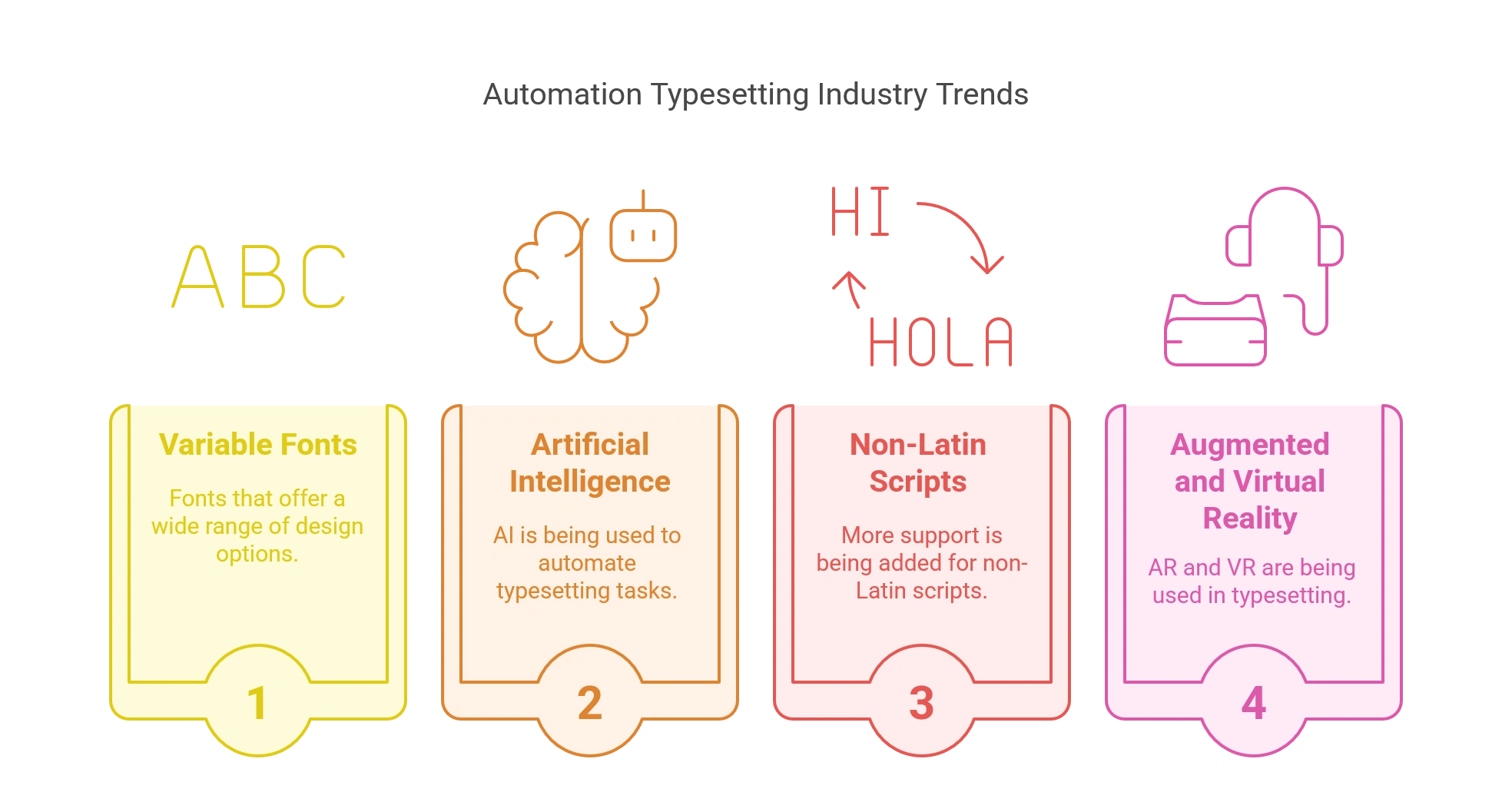
What are the Predictions and Trends in the Automation Typesetting Industry?
The RPA market is expected to grow to $20.1 billion by 2030. While AI is one of the trends we will discuss here, other exciting innovations will significantly shape the typesetting industry’s future.
Let us take a close look at a few of them.
1. Variable Fonts
Variable fonts have transformed the world of typography and, in turn, the typesetting industry. Traditionally, the weights and the various types of each font were stored in multiple font files, which impacted the overall file size. It is a crucial consideration in web typography, where page load times are critical.
Variable fonts are new fonts containing a single file that can be manipulated to any size, weight, and style. With traditional fonts, you are limited to the weights and styles that the font designer has provided. Designers can create custom fonts that suit any design needs with variable fonts.
Here are the primary benefits that variable fonts will bring to the typesetting industry.
- They will reduce the file size of a font family by up to 90%, as all of a font’s possible weights and styles will be stored in a single file.
- They will significantly improve the performance of web pages as web browsers will only need to download a single font file rather than multiple font files.
Perhaps the biggest change variable fonts will bring to the typesetting world is the ability to create responsive typography. Simply put, the font can automatically adjust its size, weight, and style to fit the size of the screen or device on which it is being viewed.
2. Artificial Intelligence in Typesetting
One cannot discuss new trends or predictions without mentioning Artificial Intelligence. This holds true for the typesetting industry as well.
Typesetting software such as Adobe’s InDesign has already started reaping the benefits of AI using Adobe’s homegrown AI tech named Sensei. It can:
- Analyze the contents of a draft and suggest optimal layouts based on the type and length of the content.
- Generate layouts automatically based on predefined templates or design guidelines.
- Provide intelligent suggestions for design elements such as fonts, colors, and images to create visually appealing content and
- Analyze text and recommend typography styles, line spacing, and other design elements that will enhance content’s readability and visual appeal.
These capabilities are just the tip of the iceberg regarding the power AI holds to transform this field. While AI has still not made its way into LaTeX typesetting, we hope it will soon.
3. Increasing Popularity in Non-Latin Scripts
Non-Latin scripts are gaining popularity as our world gets more multilingual. Non-Latin script typesetting presents unique problems, but we are seeing new techniques and resources that will help typesetters effectively overcome these hurdles.
Font libraries now include various options for non-Latin scripts, enabling designers to create visually appealing and culturally appropriate typography. Furthermore, typesetting companies continually improve their software’s support for non-Latin scripts, facilitating seamless integration and collaboration worldwide.
4. The Rise of Augmented Reality (AR) and Virtual Reality (VR)
Apple’s recent introduction of the Vision Pro Goggles gave us a glimpse into the future of how we may work and consume content. It opens up exciting opportunities for typography and the typesetting industry to explore innovative ways of presenting the written word.
Augmented reality can facilitate interactive typographic experiences, enabling users to engage with and manipulate typography within the virtual world. On the other hand, virtual reality will provide designers and typesetters with the opportunity to create immersive typographic environments.
It can be done by utilizing three-dimensional space to craft distinctive and captivating experiences. These innovative technologies could dramatically change how we perceive and interact with typographic content.
Conclusion
Automation is here to stay, with the global typesetting software market expected to reach $2.06 billion by 2030 from $1.02 billion in 2017.
In this scenario, it’s important to leverage automation in typesetting to become a successful author or designer.
Though automated typesetting makes self-publishing convenient for individuals and publishing houses, it has a learning curve. Without proper training, modern typesetters can run into several challenges. For this reason, outsourcing typesetting services may be more beneficial if you want to save time and money.
Hurix Digital provides customized digital prepress services to meet your publishing needs. Equipped with a team of expert typesetters and state-of-the-art technology, Hurix strives to convert your manuscripts into quality print-ready formats.
To know more about automated typesetting services, get in touch with Hurix Digital.
Summarize with:

Vice President – Content Transformation at HurixDigital, based in Chennai. With nearly 20 years in digital content, he leads large-scale transformation and accessibility initiatives. A frequent presenter (e.g., London Book Fair 2025), Gokulnath drives AI-powered publishing solutions and inclusive content strategies for global clients
 Upcoming Masterclass | Build an Army of Brand Evangelists using Training & Development | November 20th, 8:30 AM PDT | 11:30 AM EDT | 10:00 PM IST
Upcoming Masterclass | Build an Army of Brand Evangelists using Training & Development | November 20th, 8:30 AM PDT | 11:30 AM EDT | 10:00 PM IST
